The Spatiotemporal Characteristics of Extreme High Temperatures and Urban Vulnerability in Nanchong, China
Abstract
1. Introduction
2. Materials and Methods
2.1. Study Area and Data Sources
2.2. The High-Temperature Characterization Method
| Grades | Judgment Criteria (Day, d) [29] |
|---|---|
| Mild | Daily maximum temperature ≥ 35 °C for 3–4 d |
| Moderate | Daily maximum temperature ≥ 35 °C for 5–7 d |
| Severe | Daily maximum temperature ≥ 35 °C for 8 d or more |
2.3. High-Temperature Social Vulnerability Evaluation Index System
3. Results
3.1. Analysis of Variation Characteristics of Heat Wave Frequency, Duration, and Intensity in Nanchong
3.2. The Spatial Characteristics of High-Temperature Heat Wave Days, Frequency, and Intensity in Nanchong
3.3. Analysis of the Spatial Pattern of High-Temperature Vulnerability Differentiation in Nanchong
4. Discussion on High-Temperature Changes and Characteristic Causes
4.1. Circulation Reason for the Extreme High Temperature in Nanchong in 2022
4.2. Cause of the Low-Temperature Period and Sudden Change Points in Nanchong in the 1980s
4.3. Regional-Scale Influences
5. Conclusions
- (1)
- The high-temperature weather events in Nanchong have shown a fluctuating upward trend. Significant mutations occurred in various indicators measuring high-temperature characteristics around 2010.
- (2)
- Exposure levels are high in the south and low in the north. The sensitivity index and adaptability decrease from the central urban area to the surrounding areas.
- (3)
- Vulnerability is pronounced in specific districts: one in the west and two in the east. Both social factors (e.g., urban surface properties and aerosol characteristics) and natural factors (e.g., solar radiation, cloud thickness, and global sea surface temperature) contribute to the vulnerability characteristics indicated here.
- (4)
- The abnormal westward movement of the WPSH and the increase in intensity are the main reasons for the breakthrough of various high-temperature indicators in 2022. The temperature trough period in the 1980s and the mutations in the high-temperature situation around 2010 are related to the global sea surface temperature change and urbanization process identified here.
Author Contributions
Funding
Institutional Review Board Statement
Informed Consent Statement
Data Availability Statement
Conflicts of Interest
References
- Climate Change 2021: The Physical Science Basis. Available online: https://www.ipcc.ch/report/ar6/wg1/chapter/summary-for-policymakers/ (accessed on 28 January 2023).
- Zampieri, M.; Russo, S.; Sabatino, S.; Michetti, M.; Scoccimarro, E.; Gualdi, S. Global assessment of heat wave magnitudes from 1901 to 2010 and implications for the river discharge of the Alps. Sci. Total Environ. 2016, 571, 1330–1339. [Google Scholar] [CrossRef] [PubMed]
- Barlough, J.E.; Stoddart, C.A.; Sorresso, G.P.; Jacobson, R.H.; Scott, F.W. Future population exposure to US heat extremes. Nat. Clim. Chang. 2015, 5, 652–655. [Google Scholar] [CrossRef]
- Sun, Y.; Hu, T.; Zhang, X. Substantial increase in heat wave risks in China in a future warmer world. Earth’s Future 2018, 6, 1528–1538. [Google Scholar] [CrossRef]
- Gao, L.; Ren, H.; Zheng, J.; Chen, Q. Diagnosis features of extreme temperature variations in China based on the NCEP-GEFS reforecasts. Trans. Atmos. Sci. 2019, 42, 58–67. (In Chinese) [Google Scholar] [CrossRef]
- Robine, J.M.; Cheung, S.L.K.; Roy, S.L.; Oyen, H.V.; Griffiths, C.; Michel, J.P.; Herrmann, F.R. Death toll exceeded 70,000 in Europe during the summer of 2003. C. R. Biol. 2008, 331, 171–178. [Google Scholar] [CrossRef] [PubMed]
- Khan, N.; Shahid, S.; Ismail, T.; Ahmed, K.; Nawaz, N. Trends in heat wave related indices in Pakistan. Stoch. Env. Res. Risk. A 2019, 33, 287–302. [Google Scholar] [CrossRef]
- You, Q.; Jiang, Z.; Xu, Y.; Guo, W.; Liu, Y.; Cao, J.; Li, W.; Wu, F.; Cai, Z.; Zhu, H.; et al. Recent frontiers of climate changes in East Asia at global warming of 1.5 °C and 2 °C. NPJ Clim. Atmos. Sci. 2022, 5, 80. [Google Scholar] [CrossRef]
- Zhou, C.; Zhang, S.; Qi, D.; Tang, X.; Li, Y. Variation Features and Impact of High Temperature in Sichuan during Last 50 Years. Plateau Meteorol. 2013, 32, 1720–1728. (In Chinese) [Google Scholar] [CrossRef]
- Cai, W.; Zhang, C.; Suen, H.P.; Ai, S.; Bai, Y.; Bao, J.; Chen, B.; Cheng, L.; Cui, X.; Dai, H.; et al. The 2020 China report of the Lancet Countdown on health and climate change. Lancet Public Health 2021, 6, e64–e81. [Google Scholar] [CrossRef]
- Chen, H.; Zhao, L.; Dong, W.; Cheng, L.; Cai, W.; Yang, J.; Bao, J.; Liang, X.; Hajat, S.; Gong, P.; et al. Spatiotemporal variation of mortality burden attributable to heatwaves in China, 1979–2020. Sci. Bull. 2022, 67, 1340–1344. [Google Scholar] [CrossRef]
- Fouillet, A.; Rey, G.; Laurent, F.; Pavillon, G.; Bellec, S.; Guihenneuc-Jouyaux, C.; Clavel, J.; Jougla, E.; Hémon, D. Excess mortality related to the August 2003 heat wave in France. Int. Arch. Occup. Environ. Health 2006, 80, 16–24. [Google Scholar] [CrossRef]
- Wolf, J.; Adger, W.N.; Lorenzoni, I.; Abrahamson, V.; Raine, R. Social capital, individual responses to heat waves and climate change adaptation:An empirical study of two UK cities. Glob. Environ. Chang. 2010, 20, 44–52. [Google Scholar] [CrossRef]
- Klinenberg, E. Heat Wave: A Social Autopsy of Disaster in Chicago; University of Chicago Press: Chicago, IL, USA, 2015; pp. 121–130. [Google Scholar]
- Hirschi, M.; Seneviratne, S.I.; Alexandrov, V.; Boberg, F.; Boroneant, C.; Christensen, O.B.; Formayer, H.; Orlowsky, B.; Stepanek, P. Observational evidence for soil-moisture impact on hot extremes in southeastern Europe. Nat. Geosci. 2011, 4, 17–21. [Google Scholar] [CrossRef]
- Inostroza, L.; Palme, M.; De La Barrera, F. A heat vulnerability index: Spatial patterns of exposure, sensitivity and adaptive capacity for Santiago de Chile. PLoS ONE 2016, 11, e0162464. [Google Scholar] [CrossRef] [PubMed]
- Ye, D.; Yin, J.; Chen, Z.; Zheng, Y.; Wu, R. Spatiotemporal Change Characteristics of Summer Heatwaves in China in 1961–2010. Clim. Chang. Res. 2013, 9, 15–20. (In Chinese) [Google Scholar] [CrossRef]
- Zhang, X.; Huang, X.; Zheng, D. Temporal and Spatial Characteristics of Heat Waves and Assessment of Vulnerability in the Yangtze River Economic Belt. Resour. Environ. Yangtze Basin 2023, 32, 440–450. (In Chinese) [Google Scholar]
- Tong, L.; Li, X.; Si, Q.; Zhang, J. Risk assessment of population exposure to heat wave: A case of Baotou City, Inner Mongolia, China. Arid Land Geogr. 2017, 40, 284–292. (In Chinese) [Google Scholar] [CrossRef]
- He, M.; Xu, Y.; Li, N.; Bai, L. Assessing Heat Wave Risk in Beijing by Remote Sensing. Ecol. Environ. Sci. 2017, 26, 635–642. (In Chinese) [Google Scholar] [CrossRef]
- Xing, P.; Yang, R.; Du, W.; Dang, B.; Xuan, C.; Xiong, F. Spatiotemporal Variation of High Temperature Day and Heat Wave in North China During 1961−2017. Sci. Geogr. Sin. 2020, 40, 1365–1376. (In Chinese) [Google Scholar] [CrossRef]
- Li, W.; Wen, X.; Zhan, L.; Wang, J.; Chen, Z.; Li, W.; You, Y. The Variation of Cooling and Heating Degree Days and Its Response to Climate Warming in Nanchong. J. China West Norm. Univ. (Nat. Sci.) 2017, 38, 334–339. (In Chinese) [Google Scholar] [CrossRef]
- Zheng, D.; Huang, X. Population Exposure Risk of Heat Wave and Its Influencing Factors at County Level in China. Areal Res. Dev. 2022, 41, 143–149. (In Chinese) [Google Scholar] [CrossRef]
- Outline of the 14th Five Year Plan for National Economic and Social Development and the 2035 Long Range Goals of Nanchong City. Available online: https://nanchong.gov.cn/zwgk/fdzdgknr/ghxx/fzgh/202104/t20210409_748281.html (accessed on 28 March 2023).
- Wang, D. Thoughts on the Construction of Chengdu-Chongqing Economic Circle in Nanchong. J. China West Norm. Univ. (Philos. Soc. Sci.) 2020, 42, 99–102. (In Chinese) [Google Scholar] [CrossRef]
- Dong, C.; Luo, M.; Wang, Y.; Liu, S. Spatial Distribution of Typical Landuse Type in Underdeveloped Industrial Cities—A Case of Jialing District in Nanchong City, Sichuan Province. ISPRS—Int. Arch. Photogramm. Remote Sens. Spat. Inf. Sci. 2014, XL-4, 51–57. [Google Scholar] [CrossRef]
- Chen, H.; Zhao, L.; Cheng, L.; Zhang, Y.; Wang, H.; Gu, K.; Bao, J.; Yang, J.; Liu, Z.; Huang, J. Projections of heatwave-attributable mortality under climate change and future population scenarios in China. Lancet. Reg. Health. West. Pac. 2022, 28, 100582. [Google Scholar] [CrossRef]
- Cai, Y.; Wu, T.; Zhang, W.; Cai, Y.; Wang, J.; Pu, M. Spatial and temporal distribution characteristics of heatwave in Sichuan Province based on REOF. J. Nat. Disasters 2018, 27, 201–208. (In Chinese) [Google Scholar] [CrossRef]
- Kim, J.; Kwon, T.; Lee, J.; Kim, Y. Identifying Major Components of Extreme Heatwave Risk Assessment Indexes in Urban Areas. KIEAE J. 2019, 19, 5–10. [Google Scholar] [CrossRef]
- Deng, T.; Geng, G.; Yang, R.; Zhang, B. Temporal and spatial variation characteristics of high temperature and heat wave in the Weihe River Basin from 1980 to 2020. Arid Land Geogr. 2023, 46, 211–221. (In Chinese) [Google Scholar]
- Sutapa, C.; Debashree, D. Mann-Kendall trend of pollutants, temperature and humidity over an urban station of India with forecast verification using different ARIMA models. Environ. Monit. Assess 2014, 186, 4719–4742. [Google Scholar] [CrossRef]
- Zhu, Y.; Li, L.; He, S.; Li, H.; Wang, Y. Peak Year Prediction of Shanxi Province’s Carbon Emission Based on IPAT Modeling and Scenario Analysis. Resour. Sci. 2016, 32, 2316–2325. (In Chinese) [Google Scholar] [CrossRef]
- Adger, W.N. Vulnerability. Glob. Environ. Chang. 2006, 16, 268–281. [Google Scholar] [CrossRef]
- Xue, Q.; Xie, M.; Guo, Q.; Wang, Y.; Wu, R.; Liu, Q. Research Progress on Urban Heat Wave Vulnerability Assessment: A Geographical Perspective. Prog. Geogr. 2020, 39, 685–694. (In Chinese) [Google Scholar] [CrossRef]
- Jenerette, G.D.; Harlan, S.L.; Brazel, A.; Jones, N.; Larsen, L.; Stefanov, W.L. Regional relationships between surface temperature, vegetation, and human settlement in a rapidly urbanizing ecosystem. Landsc. Ecol. 2007, 22, 353–365. [Google Scholar] [CrossRef]
- Frazier, T.G.; Thompson, C.M.; Dezzani, R.J. A framework for the development of the SERV model: A Spatially Explicit Resilience-Vulnerability model. Appl. Geogr. 2014, 51, 158–172. [Google Scholar] [CrossRef]
- Zhou, C.; Wang, L.; Guo, S.; Song, Y.; Yang, Y. Spatiotemporal Characteristics and Prediction Model of Heat Waves in Sichuan Basin. Plateau Mt. Meteorol. Res. 2014, 34, 51–57. (In Chinese) [Google Scholar]
- Wang, B. Characteristics of Drought Disaster and Countermeasures of Artificial Rain Enhancement and Drought Resistance in Nanchong City. J. Smart Agric. 2022, 2, 47–49. (In Chinese) [Google Scholar] [CrossRef]
- Cheng, B.; Sun, W.; Guo, Q. Analyses of Climatological Features of the Summer High Temperature and Circulation Situation in Chongqing. J. Southwest Univ. (Nat. Sci. Ed.) 2010, 32, 73–80. [Google Scholar] [CrossRef]
- Sun, C.; Cheng, Z.; Mao, X.; Mei, S.; Yang, X. Analysis of Extreme Climate Change Trends and Characteristics in Sichuan Province in the Last 44 Years. J. Lanzhou Univ. (Nat. Sci.) 2017, 53, 119–126. (In Chinese) [Google Scholar] [CrossRef]
- Soledad, C.; Mariana, B.; Matilde, R. Association between El Nino and extreme temperatures in southern South America in CMIP5 models. Part 1: Model evaluation in the present climate. Clim. Res. 2021, 83, 111–132. [Google Scholar] [CrossRef]
- Cai, J.; Guan, Z.; Yu, T.; Lu, C. A classification of the summertime temperature patterns in the middle and lower reaches of the Yangtze River and their causes II: Interdecadal variations. Acta Meteorol. Sin. 2011, 69, 112–124. [Google Scholar] [CrossRef]
- Wang, Y.; Wang, F.; Sun, X. Sinuosity of Atmospheric Circulation over Southeastern China and Its Relationship to Surface Air Temperature and High Temperature Extremes. Atmosphere 2021, 12, 1139–1154. [Google Scholar] [CrossRef]
- Chen, S.; Xu, F.; Li, Y.; Du, J.; Tu, S.; Ji, Q.; Yang, J.; Zhang, S.; Zhang, Y.; Zhi, S. Summer SST in the Northwest Pacific in the Past 70 Years and Its Correlation with the Variation of the Western Pacific Subtropical High. J. Trop. Meteorol. 2020, 36, 846–854. [Google Scholar] [CrossRef]
- Chaluvadi, R.; Varikoden, H.; Mujumdar, M.; Ingle, S. Variability of West Pacific Subtropical High and its Potential Importance to the Indian Summer Monsoon Rainfall. Int. J. Climatol. 2021, 41, 4047–4060. [Google Scholar] [CrossRef]
- Roja, C.; Hamza, V.; Milind, M.; Lingle, S.T.; Kuttippurath, J. Changes in large-scale circulation over the Indo-Pacific region and its association with 2018 Kerala extreme rainfall event. Atmos. Res. 2021, 263, 105809. [Google Scholar] [CrossRef]
- Liang, L.; Chen, M.; Huang, D. Spatiotemporal change and non-stationarity of air temperature in China from 1959 to 2018. Sustain. Cities Soc. 2022, 87, 104227. [Google Scholar] [CrossRef]
- Wang, S.; Jiao, S.; Xin, H. Spatio-temporal characteristics of temperature and precipitation in Sichuan Province, Southwestern China, 1960–2009. Quat. Int. 2013, 286, 103–115. [Google Scholar] [CrossRef]
- Xia, F.; Zhao, J. Research on annual extreme temperature in recent 51 years in Leshan, Sichuan Province. J. Earth Environ. 2015, 6, 1–10. (In Chinese) [Google Scholar] [CrossRef]
- Li, Y.; Li, C. The Relationship between the Cooling of Air Temperature in Sichuan Basin and the Anomalies of SST over Tropical Western Pacific during the Last More Than 40 Years. Clim. Environ. Res. 1999, 4, 388–395. (In Chinese) [Google Scholar] [CrossRef]
- Zhang, T.; Wang, Y.; Cheng, B. Long-term Variation of Aerosol Optical Depth over Sichuan Basin of China During 1961—2013 and its Relationship with Temperature. Acta Sci. Circumstantiate 2017, 37, 793–802. (In Chinese) [Google Scholar] [CrossRef]
- Qin, X.; Wu, X.; Chiew, Y.M.; Li, Y. A Green Roof Test Bed for Stormwater Management and Reduction of Urban Heat Island Effect in Singapore. Br. J. Environ. Clim. Chang. 2013, 2, 410–420. [Google Scholar] [CrossRef]
- Van, T.T.; Bao, H.D.X. Study of the Impact of Urban Development on Surface Temperature Using Remote Sensing in Ho Chi Minh City, Southern Vietnam. Geogr. Res. 2010, 48, 86–96. [Google Scholar] [CrossRef]
- Senbore, S.; Oke, S.A.; Kirsten, M. Urban development impact on climate variability and surface water quality in part of Mangaung metropolis of South Africa. Dev. South. Afr. 2023, 40, 293–312. [Google Scholar] [CrossRef]
- Liu, Y. Study on Greenbelt System and Heat Island Effect in Main Urban Area of Nanchong. Master’s Thesis, Chengdu University of Technology, Chengdu, China, 2021. [Google Scholar]
- Jia, W.; Ren, G.; Suo, N.K.; Zhang, P.; Wen, K.; Ren, Y. Urban Heat Island Effect and its Contribution to Observed Temperature Increase at Wuhan Station, Central China. J. Trop. Meteorol. 2019, 25, 102–113. [Google Scholar] [CrossRef]
- Sun, T.; Sun, R.; Chen, L. The Trend Inconsistency between Land Surface Temperature and Near Surface Air Temperature in Assessing Urban Heat Island Effects. Remote Sens. 2020, 12, 1271. [Google Scholar] [CrossRef]
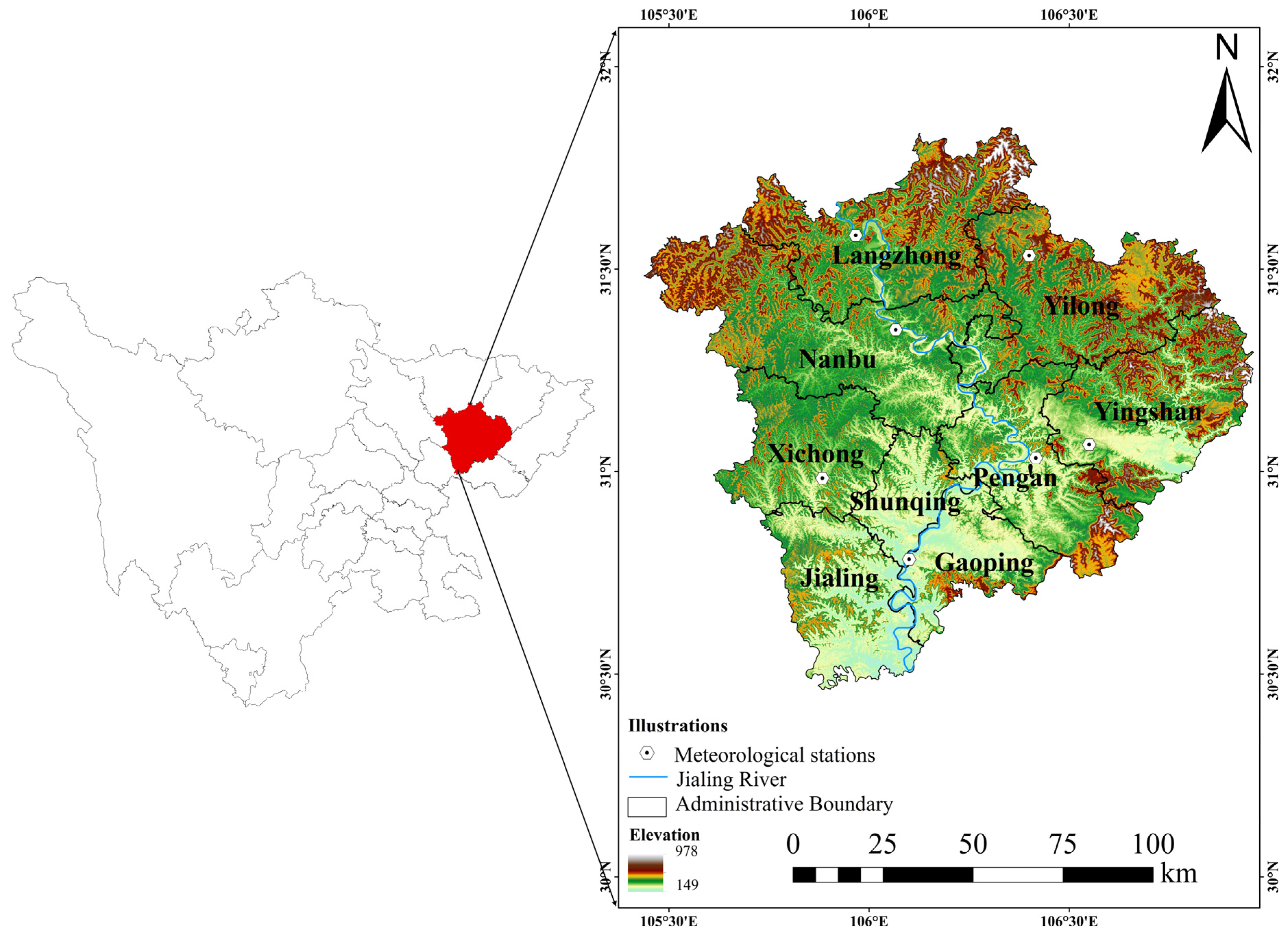
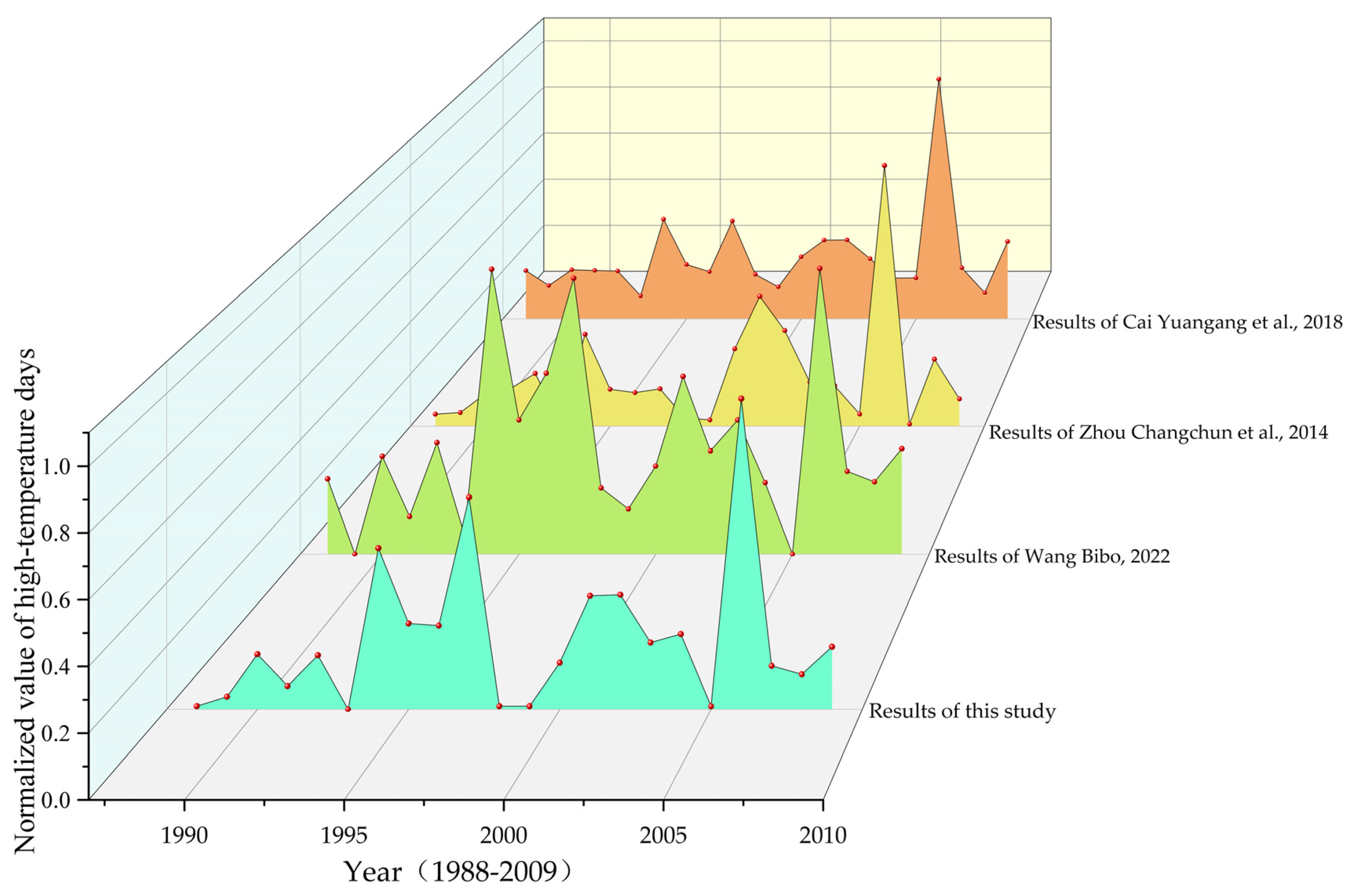
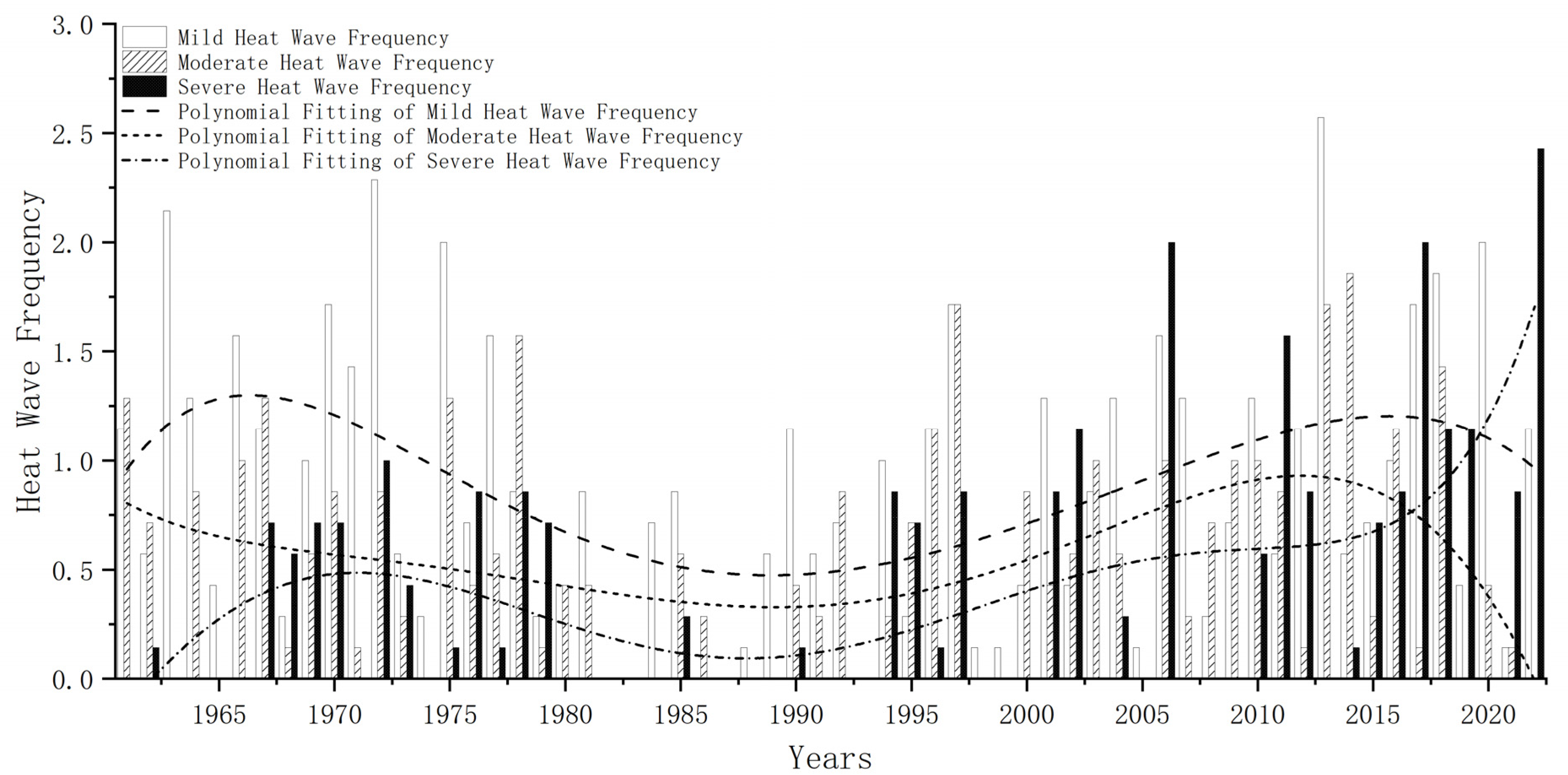
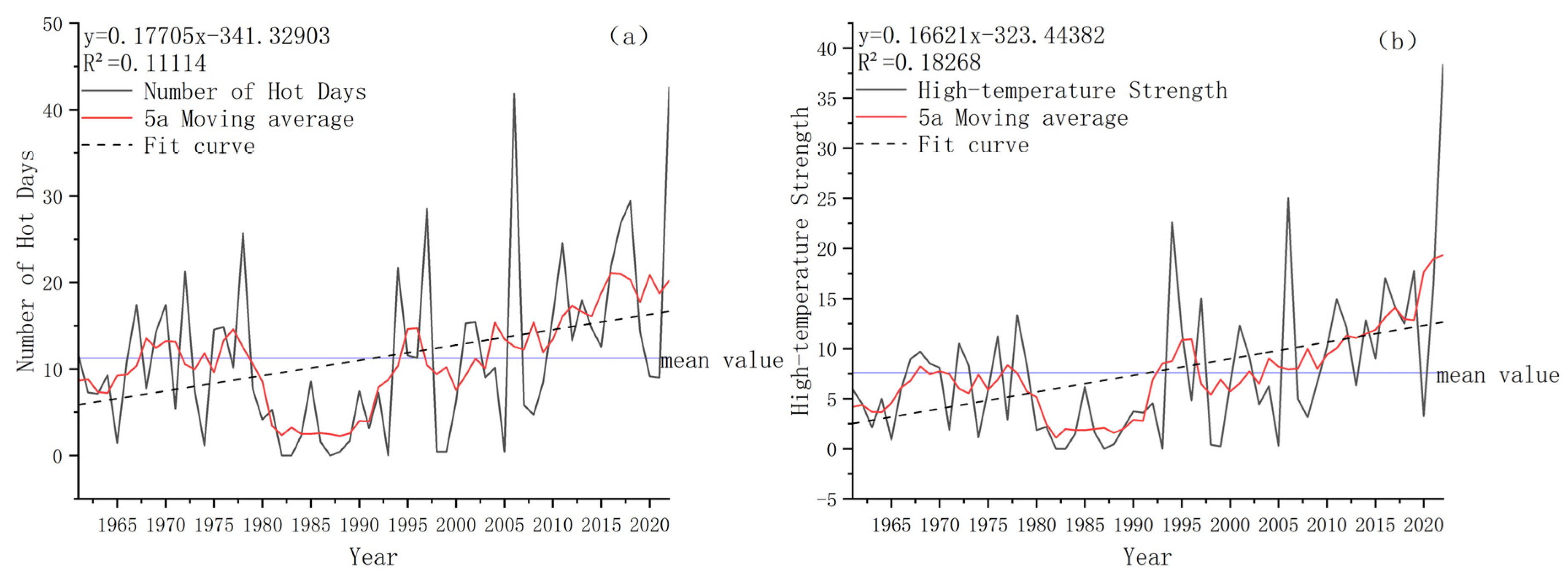

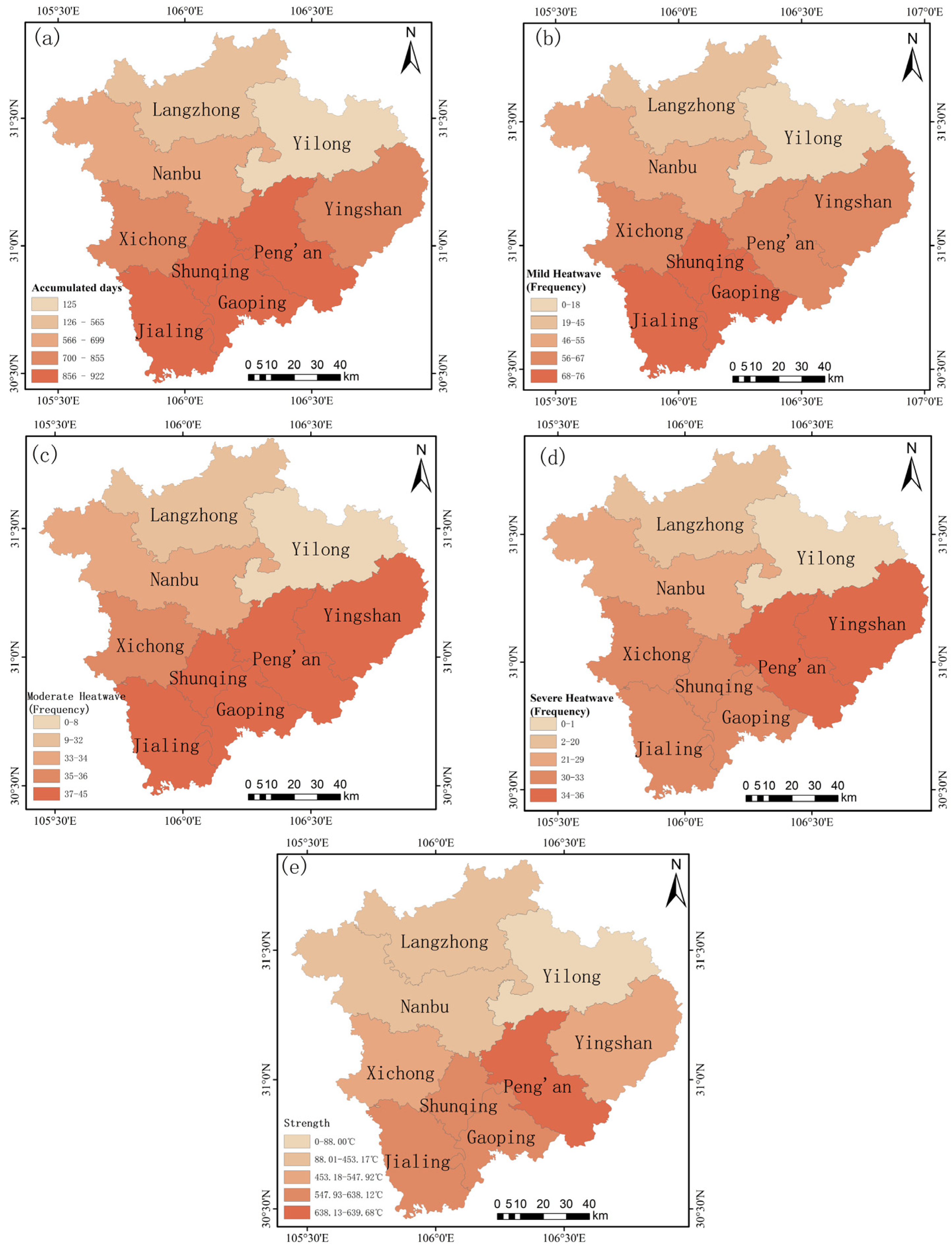
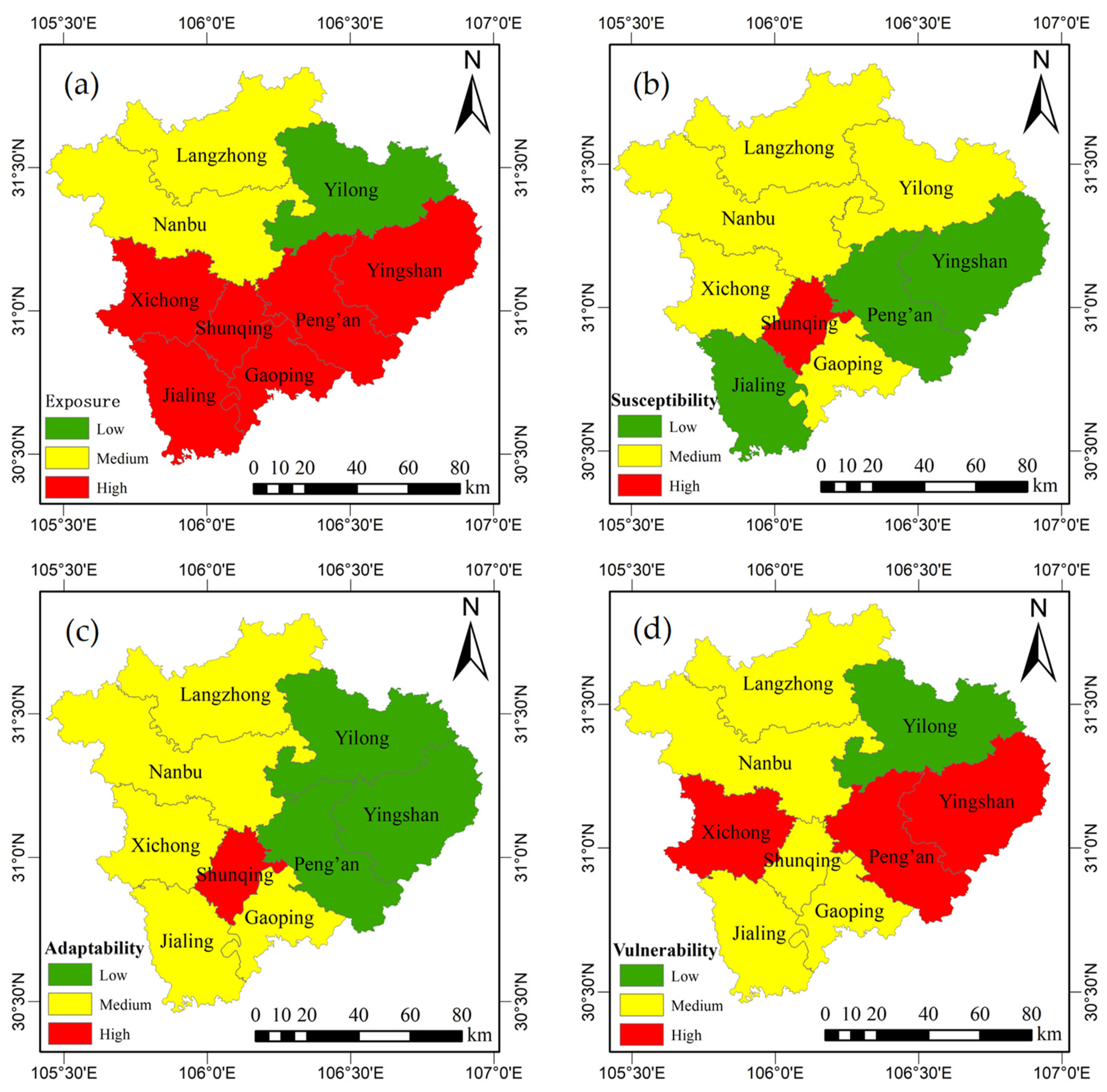

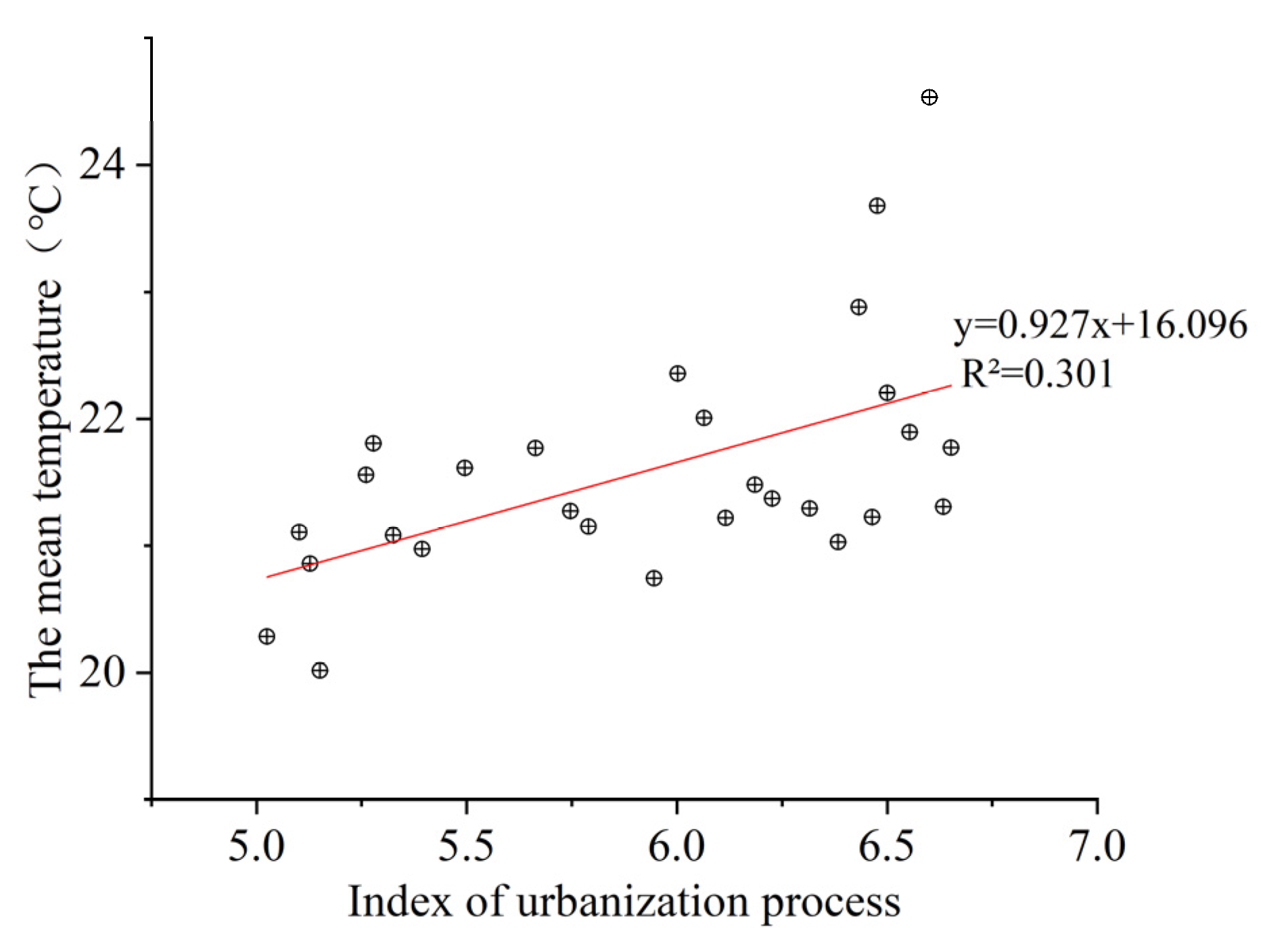
| Target Layer | Dimension | Weights | Indicator Layer |
|---|---|---|---|
| High-temperature social vulnerability | Exposure level | 0.3313 | Number of high-temperature days |
| 0.3291 | Heat wave frequency | ||
| 0.3396 | High-temperature intensity | ||
| Sensitivity | 0.0778 | Rural population ratio | |
| 0.6098 | Population density | ||
| 0.1355 | Percentage of the population over 65 years old | ||
| 0.1770 | Proportion of people employed in the construction industry | ||
| Adaptability | 0.1601 | Number of medical beds | |
| 0.2028 | Proportion of people working in the medical and nursing industry | ||
| 0.2094 | GDP per capita | ||
| 0.3514 | Greenery coverage | ||
| 0.0764 | Average number of air conditioners per household |
| Month | Area of WPSH | Strength of WPSH | Ridge Position | Location of the Western Ridge Point | |
|---|---|---|---|---|---|
| Mean value of 30 a in | 6 | 88.11 | 196.85 | 21.4 | 121.55 |
| 2022 | 6 | 82.5 | 194.1 | 21.7 | 124.5 |
| Mean value of 30 a in | 7 | 77.58 | 172.05 | 26.52 | 124.57 |
| 2022 | 7 | 128.6 | 314.6 | 25.5 | 113.1 |
| Mean value of 30 a in | 8 | 79.06 | 181.13 | 29.04 | 124.82 |
| 2022 | 8 | 164.9 | 456.5 | 30 | 90 |
Disclaimer/Publisher’s Note: The statements, opinions and data contained in all publications are solely those of the individual author(s) and contributor(s) and not of MDPI and/or the editor(s). MDPI and/or the editor(s) disclaim responsibility for any injury to people or property resulting from any ideas, methods, instructions or products referred to in the content. |
© 2023 by the authors. Licensee MDPI, Basel, Switzerland. This article is an open access article distributed under the terms and conditions of the Creative Commons Attribution (CC BY) license (https://creativecommons.org/licenses/by/4.0/).
Share and Cite
Yin, Z.; Li, W.; Chen, Z.; Shui, P.; Li, X.; Qin, C. The Spatiotemporal Characteristics of Extreme High Temperatures and Urban Vulnerability in Nanchong, China. Atmosphere 2023, 14, 1318. https://doi.org/10.3390/atmos14081318
Yin Z, Li W, Chen Z, Shui P, Li X, Qin C. The Spatiotemporal Characteristics of Extreme High Temperatures and Urban Vulnerability in Nanchong, China. Atmosphere. 2023; 14(8):1318. https://doi.org/10.3390/atmos14081318
Chicago/Turabian StyleYin, Zhaoqi, Weipeng Li, Zhongsheng Chen, Panheng Shui, Xueqi Li, and Chanrong Qin. 2023. "The Spatiotemporal Characteristics of Extreme High Temperatures and Urban Vulnerability in Nanchong, China" Atmosphere 14, no. 8: 1318. https://doi.org/10.3390/atmos14081318
APA StyleYin, Z., Li, W., Chen, Z., Shui, P., Li, X., & Qin, C. (2023). The Spatiotemporal Characteristics of Extreme High Temperatures and Urban Vulnerability in Nanchong, China. Atmosphere, 14(8), 1318. https://doi.org/10.3390/atmos14081318







